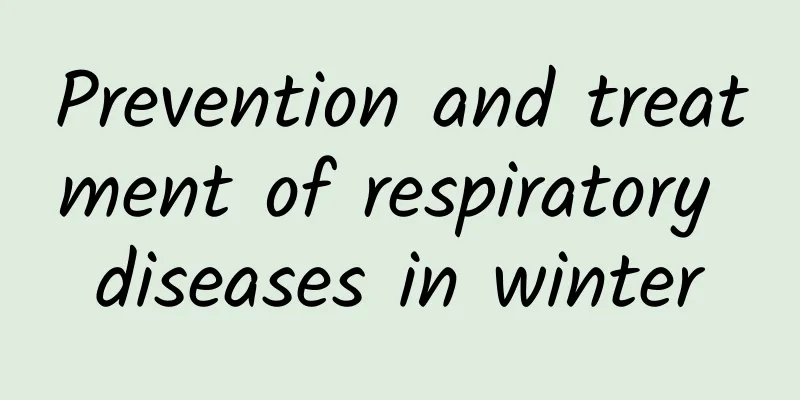Prevention and treatment of respiratory diseases in winter

|
How is the prevention and treatment of respiratory diseases in winter? The National Health Commission’s press conference gave an authoritative response Anhui Provincial Emergency Management Department The National Health Commission held a press conference on December 10 to introduce the prevention and treatment of respiratory diseases in winter. How can schools, childcare institutions, public transportation and other key places do a good job in respiratory disease prevention and control? What should families with young children and the elderly pay attention to? Pay attention together - The overall number of children's respiratory disease diagnosis and treatment shows a fluctuating downward trend At present, the overall number of children's respiratory disease diagnosis and treatment in medical institutions above the second level nationwide shows a fluctuating downward trend , and the increase in pediatric diagnosis and treatment in some large children's specialized hospitals and general hospitals has been alleviated to a certain extent. Judging from the overall situation of fever clinics and emergency departments, the number of patients with respiratory diseases in the country has been relatively stable in recent times , especially the primary medical institutions have diverted some patients. The overall normal medical services in the country have not been affected. We must give full play to the role of medical alliances, medical communities, medical groups and Internet medical services, establish a mechanism for cooperation between general hospitals and primary medical institutions, expert sinking and patient referral, and stratify and grade diversion to facilitate patients to choose medical treatment reasonably . We must give full play to the unique advantages of traditional Chinese medicine, combine traditional Chinese and Western medicine, and improve the prevention and treatment effects. Primary and secondary schools, childcare institutions, nursing homes, social welfare institutions and other key places and crowded places should implement ventilation and disinfection measures, strengthen health science popularization and health monitoring, do a good job in personal protection, reduce disease transmission, and reduce the risk of infection. We must continue to do a good job in vaccination and continuously optimize vaccination services. About respiratory disease protection Question: What measures should be taken to prevent the spread of respiratory diseases in key institutions and places, such as schools, childcare institutions, public transportation, etc.? answer: For schools and childcare institutions: First, vaccination should be carried out as soon as possible. Students, faculty and staff should be vaccinated against influenza and other diseases as early as possible to improve their own immune barrier and reduce the risk of disease. The second is to strengthen environmental cleaning, maintain indoor hygiene, open windows for ventilation regularly , keep indoor air flowing, and improve classroom air quality. However, the outdoor temperature is relatively low in winter and spring, so you must pay attention to keeping warm when opening windows for ventilation. Third, it is recommended to strengthen health monitoring , conduct morning and afternoon inspections, and register absences. Students and faculty members are advised not to go to work or attend classes when they are sick to prevent the spread of infectious diseases into schools or classrooms. For public transportation: First, it is necessary to clean and disinfect the interior of the vehicle, maintain the air quality inside the vehicle, and ventilate the vehicle regularly. Second, it is recommended to wear masks during the peak season for respiratory infectious diseases to reduce the risk of exposure and illness, and be the first person responsible for your own health. Q: What protective measures should be taken when there are young children and elderly people at home? answer: First, start vaccination as soon as possible. Vaccination can actually reduce infection and the risk of severe illness, and it is also the most economical and effective means of preventing infectious diseases. Young children and the elderly should be vaccinated against COVID-19, influenza, and pneumococcal vaccines as soon as possible. Second, during the peak season for respiratory infectious diseases, young children and the elderly should try to avoid going to crowded and relatively closed places . If they must go, it is recommended to wear masks to reduce the risk of infection with respiratory infectious diseases. Third, we must strengthen daily health monitoring of the elderly and young children . If symptoms of respiratory infection such as fever and cough occur, they should seek medical attention as soon as possible. At the same time, they should follow the doctor's advice and use medications scientifically and safely. Fourth, if a family member has a respiratory infectious disease, they should avoid contact with other family members , especially young children and the elderly. If a child with respiratory symptoms such as coughing or fever comes to see a doctor, you should take good personal protection for the child and yourself to avoid cross infection. About Tiered Diagnosis and Treatment Question: In response to a possible peak in patient visits, what contingency plans have secondary hospitals developed? answer: First, the entire hospital coordinates as a whole, implements daily scheduling, and keeps real-time track of the number of consultations, treatments, drug supplies, and bed usage in key departments such as the fever clinic, emergency department, and pediatrics . The second is to give full play to the role of the information system, use data trends as a guide, timely and effectively dispatch the resources of the entire hospital, set early warning red lines, optimize the handling process, ensure the supply of medical services , and maintain normal diagnosis and treatment order. The third is to continuously optimize the existing fever clinics, outpatient clinics and emergency coordination mechanisms, and adopt multiple measures to enhance the reception capacity. In terms of personnel reserve, arrangements have been made. First, timely replenishment of medical forces to ensure the reception capacity of key positions. Second, training, teaching and drills on the diagnosis and treatment of respiratory infectious diseases were carried out for relevant professionals throughout the hospital to enhance the professional diagnosis and treatment capabilities of the reserve team. We have also made arrangements for drug preparation. First, we will continue to ensure the supply of relevant drugs. For winter respiratory diseases, we will dynamically adjust the list of key drugs in combination with the actual medical situation. Second, we will strengthen drug use monitoring, scientifically formulate procurement plans, timely organize scientific evaluations, direct reporting of shortage information, and reasonably select alternative drugs to ensure clinical treatment needs. Third, we will strengthen the management of standardized drug use, give full play to the role of clinical pharmacists, strengthen rational drug use reviews, and provide good guidance for patients on drug use. About Flu Vaccination Question: If you have flu-like symptoms but have not been diagnosed and recovered, should you continue to get the flu vaccine? answer: If you have already developed flu-like symptoms, and you have recovered without being diagnosed, it is still recommended to continue to get the flu vaccine . There are two main reasons: First, the symptoms of respiratory infections are not specific, and multiple pathogens may cause flu-like symptoms such as fever and headache. However, these symptoms do not necessarily mean that you are infected with the influenza virus, but may also be infected with other pathogens, the most common of which is the common cold. Second, there are multiple types and subtypes of influenza viruses that can cause epidemics, and after being infected with a certain type or subtype, you may also be at risk of infection with other types or subtypes. The influenza vaccine is a multivalent vaccine that covers a variety of different types and subtypes, which is the trivalent and quadrivalent vaccine we usually use. If you are vaccinated after being infected with a certain type of influenza, it contains other types of influenza components, which can still play a role in preventing that type of influenza . Therefore, even if you have had flu symptoms recently, it is recommended to get the flu vaccine as soon as possible after recovery. The influenza vaccine generally takes effect two weeks after vaccination. However, respiratory diseases are easy to spread, so you should develop good personal hygiene habits and a healthy lifestyle to reduce the risk of respiratory disease infection. |
Recommend
What if my period is delayed for ten days and my vaginal discharge increases?
Delayed menstruation is a common problem for many...
Peach gum = cheap bird's nest? Is it really that magical?
In the spring, peach blossoms bloomed quietly, pe...
5 social media trends to watch in 2016
In the past, we could only rely on two things: de...
Breast cancer stage 5
Breast cancer has become a disease with an increa...
What are the causes of cysts in women?
Ovarian cyst is a relatively common gynecological...
Ten recommendations for exercise for patients with cardiovascular disease! European Heart Journal
Last August, the European Society of Cardiology (...
Pregnant women's recipes and methods
After pregnancy, you must pay special attention t...
What to do if a girl is physically weak
Dietary supplements are better than drug suppleme...
Second pregnancy scar uterine thickness dangerous
Most women choose cesarean section when giving bi...
What should I do if my belly is hard during my fifth month of pregnancy?
For pregnant friends who have a hard belly at fiv...
Can I take medicine for a cold during late pregnancy?
The entire process of pregnancy is very important...
Can I eat yellow peaches during menstruation?
Yellow peach is a favorite choice for many people...
What are the symptoms of early fetal arrest?
The early pregnancy is also called the early stag...
How to treat cervicitis
When talking about common gynecological diseases,...
Is it dangerous to have three caesarean sections?
Not to mention the various pain problems some mot...









